My Life Through Four Sewing Machines
The Clothes I have Made, Treasured and Given Away
Tote Bag Jacket - made from tote bags gathered at the Romantic Novelists gathering
I’ve recently been overcome by an urge to purge – possessions, that is. It started when builders finally left my house after seven months – the more I threw out, the less I had to clean. I needed to make space for guests to join a house swap agency. Re-writing my will made me think, ‘I can’t leave all this for my executors to clear.’ I had no idea what Swedish Death Cleaning was, but someone suggested I was doing that – and apparently it’s a really healthy thing to do.
I’d also read Patrick Grant’s (he of Sewing Bee fame) book Less which said we should have fewer items of better quality. He particularly focused on clothes, but he didn’t warn readers how hard it is to give away clothes you’ve made yourself. If you sew, you remember why you chose a pattern, where you bought the fabric, what the weather was like while you were spending hours making the outfit, and where you wore it. I had literally hundreds of gorgeous hand-made clothes, spanning 46 years – sending those to the charity shop was going to be hard-despite post-menopausal weight gain and changing taste meaning some were unlikely to be worn again. But I’ve started. Bags and bags to the local charity shop. How? I had to give myself a Sentimentality Bypass – and write this, a eulogy to the clothes I’d made and treasured.
Sewing Machine No 1 – hand turned
At 11, I started Wickham Hall Comprehensive School in Banbury. It was something I’d been dreading – I had heard the school was rough and new kids were bullied. That wasn’t true, as I found out. I loved it there. I had a truly eccentric form teacher, who once arrived wearing only her petticoat as she’d forgotten to put her skirt on. I liked most of the new grown up subjects. I’m still friends with two of the girls I met that year – Carolyn and Penny. Penny will feature again in this tale.
One of the subjects was needlework. I don’t think we made an actual garment during that year, but we did cover the basics of how to use a sewing machine, seams, and some hand-sewing techniques like hemming. I’ve never been very good at getting my body to follow visual teaching. My mother had never sewn. Though we had absolutely no money back then, she managed to get me a sewing machine so I could practice and not be embarrassingly bad at school. A neighbour over the road had upgraded to a (sigh in envy!) electric sewing machine, and I was given her old hand-cranked job. It had long thin bobbins. It only did straight stitch, and I don’t think it even did reverse stitching, but it was the best present ever. Even then I liked clothes – I didn’t have the autonomy to buy myself fabric – but I think I must have tried to make miniature outfits for Barbie/Tressy dolls from donated scraps as a would-be fashion designer.
We moved from Banbury to Worcester during the Whit half term that year. I had to start at the Girls Grammar School (attending much against my protests – I wanted to go to the closer mixed comprehensive). And yes, I hated it as much as I’d feared – an obsessional uniform, strict regime, and teaching by humiliation. But, of course, I made lasting friends. Sheila is a sewing buddy to this day. Again, needlework was on the curriculum. The teacher was perturbed as the class had been making cookery aprons for two and a half terms and I only had a few weeks to make mine before Domestic Science in Year 2. My decidedly average ‘C’ grade from the previous school can’t have been encouraging either. Anyway, Miss Croft looked me up and down, and said, ‘You look like a gel who can follow instructions and really that’s all there is to sew from a pattern – you don’t need to be artistic – just carefully follow each step in order. And how marvellous you’ve got a sewing machine at home! You’ll be able to finish it in five weeks’. And I did. I loved not having someone telling me off over my shoulder. I’d take my work-in-progress to each class and got shown all the techniques to neaten seams, make darts, attach waistbands, fit-to-figure and how to cut and blanket stitch buttonholes. I was off!
I don’t think we did needlework in Year 2 (learned to make pastry and 70s puddings instead) but it was back on the curriculum by Year 3. The first proper garment I remember making was a green paisley-patterned needlecord A line skirt with my first zip insertion. We also had to make our ‘middle school’ summer dresses – you only had three fabrics to choose from, but you could choose any pattern, provided you followed the rules for length etc. My parents somehow came up with the money for essential projects, but I instinctively knew I couldn’t ask for more. I’d save up my limited pocket money and birthday cash until I had enough to buy a pattern and some fabric from the market, and as it wasn’t enough, I started earning as soon as I could – baby-sitting jobs (I’m still in touch with two of the mums) and got my first Saturday job in Freeman Hardy Willis when I was 14. I made all my own clothes on that old hand machine right through my teens, and I’ve still got some of the patterns I used, and made later variations.
When Anne was 14 and the needlecord dress
Back in the 1970s – my first trip abroad, age 14, with my French exchange student in a handmade dress. Countless pencil skirts made for the first pattern, and I made a tiered skirt (from beautiful recycled Liberty lawn cotton) only a couple of years ago.
At the end of Year 3, we had to choose our ‘O’ level subjects. Needlework was absolutely the top of my list – you were taught full tailoring techniques - but I wasn’t allowed to do it as I was ‘too clever’. I was forced to do Divinity. Funnily enough it put me off God for life and made me even more determined to sew. I was absolutely livid and, being a woman who knows how to hold a grudge, I can still rant about it over 50 years later. I continued to make my own clothes – I was able to build up quite a fashionable wardrobe as it was then much cheaper to make your own. I had kept in touch with Penny from Banbury, and we’d started to meet up in Oxford by train, buying Laura Ashley fabrics for long flowing dresses, and we spent weekends at each other’s houses. I was able to strike a deal with her – she told me about all of her ‘O’ level needlework assignments, so I got to learn lots more techniques anyway.
I left the dreaded school at 15 (9 O levels for me, and a share of Penny’s A grade in Needlework), and transferred to the local technical college, much to the dismay of Miss Harvey, the Girls’ Grammar head – I suspect she not only had me in line for Head Girl but also wanted to recruit me as a spy, but I wasn’t going to be bullied into studying Russian by anyone! I carried on making trendy clothes – a friend sent a photo of me listening to Radio Luxembourg on headphones wearing a paisley maxi dress made in 1974, and I remember learning to make ‘loon’ trousers. The trusty sewing machine accompanied me when I moved to London just before my 19th birthday, and as well as making my own clothes, it was when I started to make things for friends’ children.
Sewing machine No 2 – a Singer Electric
When living in London I was seduced by a slightly older man (so many of us know that story), who took a job in California. He asked if I’d go with him. There was one big disadvantage to this – I’d have to marry him to get a green card – but hey ho! You’re only young once – and I did fancy living in California. I lived in the Bay Area (Silicon Valley), and later the Santa Cruz Mountains, from 1978-1982. I have very fond memories of it, despite the husband – the majesty of the redwoods, the freedom, the bands, and I’m still in touch with many of the friends I made.
Ready for the wedding
I didn’t take the wedding very seriously – my vow was to stay with him ‘until life us do part’– but it was a bloody good excuse to buy a new sewing machine to make my wedding dress, and to indulge my love of dressing up. I thought I was making a wise choice with a Singer electric machine, but Singer didn’t make quality machines in the 1970s, and I remember really struggling to sew the slippery velvet I’d chosen. I fancied the gown worn in a portrait of Anne Boleyn. I didn’t know how to draft patterns back then, and commercial patterns for costumes were uncommon. Someone had a friend in the theatre who made me a pattern. I not only wore the dress for the wedding, but it had outings to several Renaissance Fayres, a feature of Northern California back in the early 1980s, and I was even wearing it to the Ale Tasting and Bread Weighing Fayre in Ashburton in 2002.
Last month it went to the charity shop, where it will sadly probably end up in the ragbag, but I gave myself a pat on the front for not holding onto it any longer – 46 years was bloody good service.
The other story from California is the Making Wearable Art workshops at a quirky fabric store in Los Gatos. They not only stocked wonderful imported (eg from Central and South America) fabrics, but also Folkwear Patterns. I’ve still got a large collection of these. In the classes we were encouraged to use the ethnic clothing range (there’s also a historical range), as they’re often made up of simple block-shaped pattern pieces which can be embellished using a variety of techniques. Through using those patterns. I became skilled in applique, patchwork, hand-embroidery, quilting, and smocking.
1970s paisley
I used yards and yards of Mexican cotton and hand-embroidered the bodice from the Afghani Nomads Dress pattern. I made it for my UK post-wedding reception, but later wore it for rituals – this photo shows me throwing my 4th Year Med School project into the river Itchen - the project had been an absolute nightmare – cycling all over hilly Southampton, interviewing older members of the population about their mental health. I remember a lonely man who had kept his budgie in the freezer after it died and insisted on showing it to me.
The Afghani nomad dress
Sewing Machine No 3 – top-of-the-range Bernina 830 Record
Inevitably my marriage ended. I felt I could walk out of our jointly-owned marital home with just my clothes – but I did feel I deserved one thing of value. I went to Mr B’s Sewing Machine shop on Geary Blvd in San Francisco, and bought the most expensive machine available – the still lauded Bernina 830 record. Every single part was metal, hand-crafted in Switzerland. It had multiple stitches and feet – anything would be possible! It came with a 26 year guarantee on all parts – and it only went wrong after 26 years and 1 month! I must have made literally hundreds of garments on that workhorse, before donating it to a friend’s daughter, after it developed the same tension fault for the third time.
I made the decision, rightly or wrongly, to return to the UK. I left with my pattern collection, and the clothes I could fit in two suitcases - and seven skirts under the voluminous Afghani Nomads Dress – with the Bernina as carry-on luggage. Those were the days!
I arrived back in the UK in May 1982 and almost immediately accompanied my family to Austria, where I visited a pen friend. I came back with some high-quality cotton (couldn’t afford it now!) and made myself a traditional dirndl, using another Folkwear pattern. It’s a boned dress over a cotton blouse with alpine cross stitch embroidery on the sleeves, and a co-ordinating apron. The apron hid the opened fastening at the front to make room for my expanding girth, New Year 2021!
After a year working to raise money in London, I started a six year medical degree in Southampton. Most of my fabric was bought at Tyrrell and Green, a branch of John Lewis, and I made simple but smart skirts to wear under white coats on the wards. I was famous for being perfectly co-ordinated – even if the matching jewellery was only plastic! After a year of house jobs - surgery then medicine - I started my psychiatry training in London, and that’s when my passion for fabrics really blossomed, with not only Liberty, but all the fabric shops, markets and haberdashers in theatre land (Soho). I specialised in suits and jackets. The next photo is an all-time favourite – made from plum raw silk from Liberty. The skirt is from the pencil skirt pattern I showed earlier, with back pleats, and the jacket had the most amazing fish tail back. I donated that to my goddess daughter.
I moved to Devon in 1996, accompanied by the trustee Bernina. Before work got too busy as a consultant, I started specialising in vintage clothing, using re-sized vintage patterns or the more modern vintage-style patterns. I used to go to vintage fairs dressed to the nines with hats, gloves – and even hair – to match the garments I’d made!
Patterns from the 1930s (it took me eight days to make that suit – and when I put it on I looked in the mirror and exclaimed, ‘Fuck! I look like a bishop!’ – not something I’d ever thought I’d say.
Wore it once to conduct a funeral through to the 1960s.
In 2003 I made the unwise decision to get married a second time. Another excuse to make an elaborate gown, and as the dress-code was - Hired costumes to match the venue – Georgian to Edwardian, everyone else got to dress up too. The gown had a boned bodice with detachable bustle/train. I made it from curtain fabric and sewed on heaps of fabric roses. I remember crying as I made it in a filthy holiday cottage in North Wales – I was so ill at the time I didn’t know if I’d be wearing it for my wedding or my funeral. From leftover fabric I made a Victorian Walking skirt for my honeymoon. Two nights in a hotel in Cornwall was all I could manage. I gave both recently given to the charity shop.
Sewing Machine No 4 – the inferior “new” Bernina 830
The next phase of my sewing life took off when I retired. I treated myself to a new Bernina, but it wasn’t really the treat I’d hoped for, as their machines are now made from plastic in Thailand. I still occasionally regret giving away my old one. Everything has its season and moves on.
It was finally my chance to get my own back on Miss Harvey for not allowing me to do that needlework ‘O’ level, and I bought books, collected vintage patterns, went on courses on pattern drafting. I even flew to Norwich for the weekend just to do a trouser block course, pattern hacking, and on advanced techniques. In lockdown I stayed sane (well, sane in my opinion) by playing Sew-along-a-Sewing-Bee.
I made a sensible variation of the first 19 of 24 challenges from that year’s series. I figured it would give me a masterclass in working with new fabrics, upcycling/transformation (“the shit-to-shit” challenge as friends and I call it) and new techniques. Few of the things I made were out-and-out disasters although the mac made from a vinyl tablecloth springs to mind. Sewing it was like tugging a hippopotamus through a narrow gap on the hottest day of the year. And some have been eminently-saleable donations – like a wearable garment made from beach towels and a Bolivian milkmaid’s jacket from a scrap of velvet and the legs from some harem pants.
The beach towel jacket
I’ve also recently donated the made-to-measure (no longer) Rosie the Rivetter dungarees, my perfectly pattern-matched palazzo pants and 70s-style blouse, a movie inspired outfit (had to be Marilyn Monroe) and in the winter-weight yet-to-be-donated bag there are at least 20 jackets and a coat made from silk/cotton ikat fabric bought in Bali and machine-quilted.
And there we are – my life so far with four sewing machines. It’s been a passion and a pleasure for someone praised for their brain and discouraged from following a fashion/design career to make lovely garments that could have come from Savile Row. In hindsight it was right to keep dressmaking for pleasure only – I would have hated being at the whim of demanding clients.
My friend Sheila is right – my trademark is making things as beautiful on the inside as on the outside. It’s why you won’t see me on this year’s Sewing Bee – there’s no way I’d turn in a garment if the seams weren’t perfectly neatened!
Back in California I learned sewing could be an art form on a par with painting, pottery, or sculpture. But you get to wear your projects too - and never have to go to a function in the same outfit as someone else.
Each garment is an embodied story – a time of your life in cloth and embellishment, a labour of love. Needlework is a way of expressing your own unique personality. I look back on the photographs and think how sad it is that I never realised at the time that I was an attractive and very stylish woman albeit in an eccentric way.
The urge to purge – and my nostalgiaectomy – mean I’ve now got wardrobe space if I want to house-swap, and maybe one day I’ll walk around town and see a young person enjoying wearing something I made in the Ashburton Atelier. I may even stop that person and tell them the garment’s unique story.
Palazzo pants that have gone to the charity shop



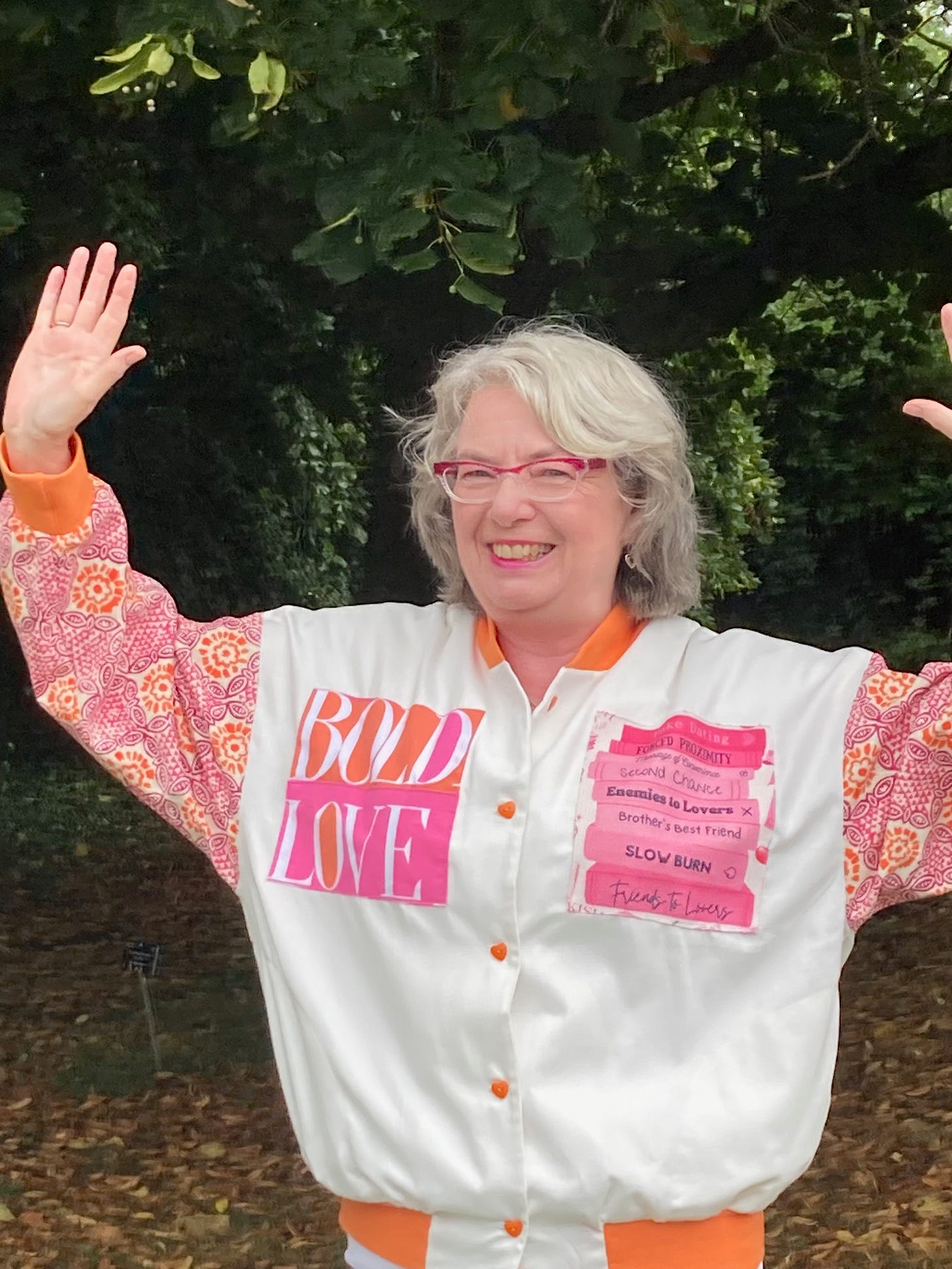
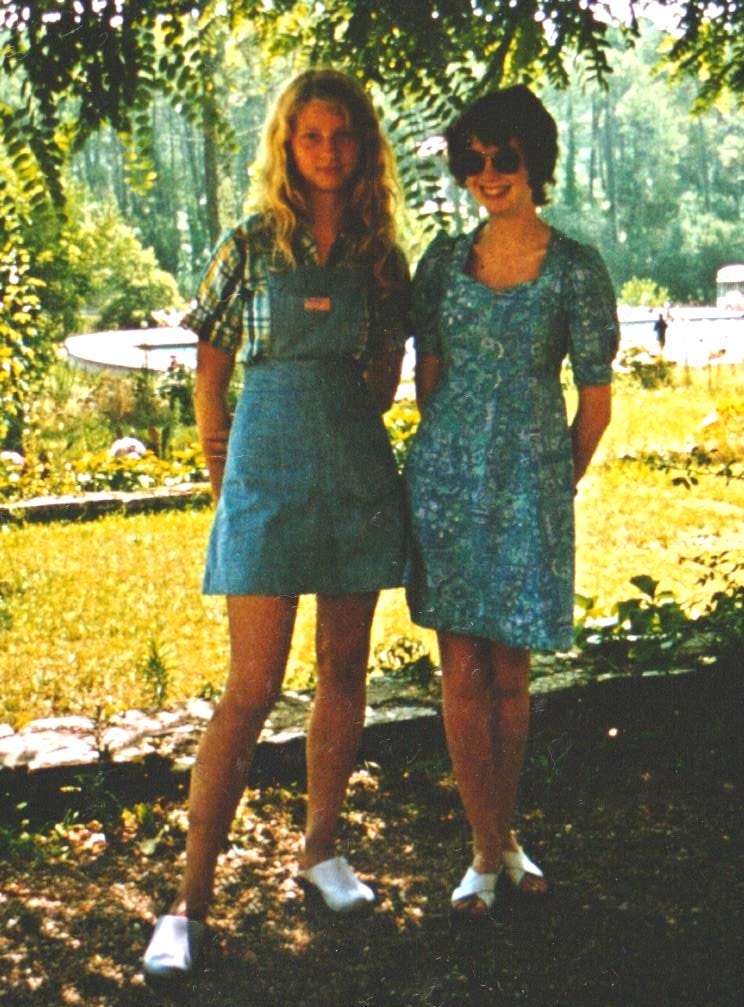
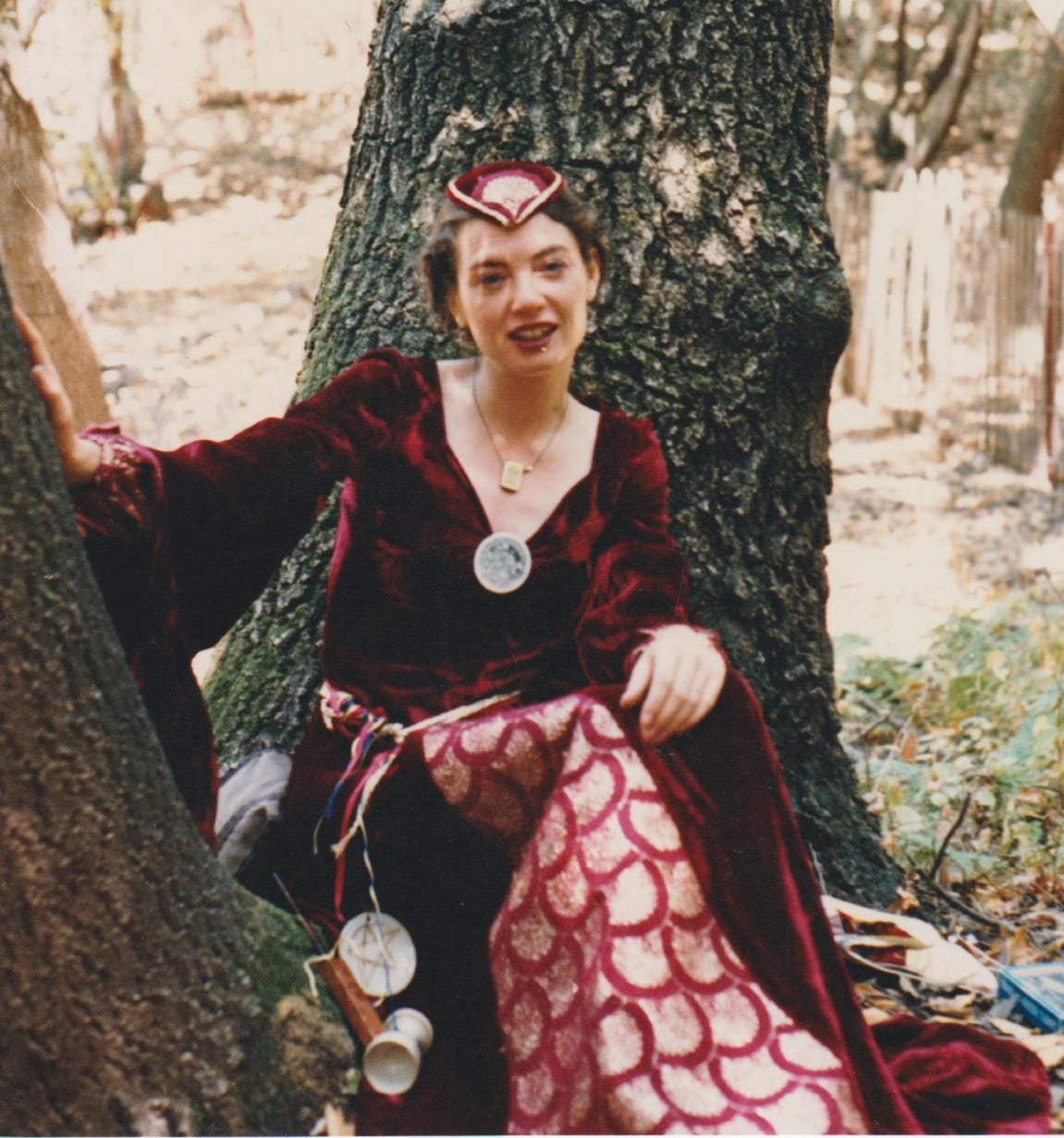

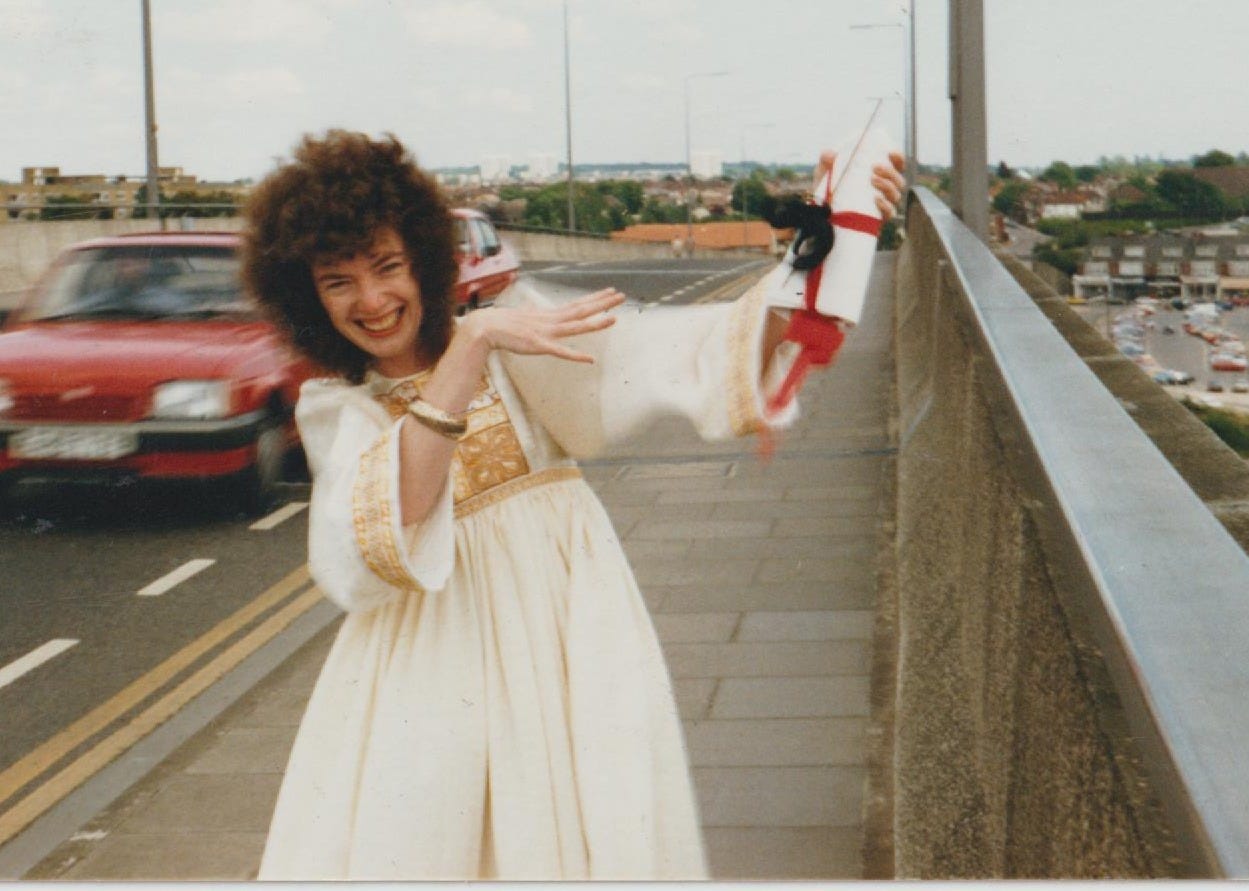

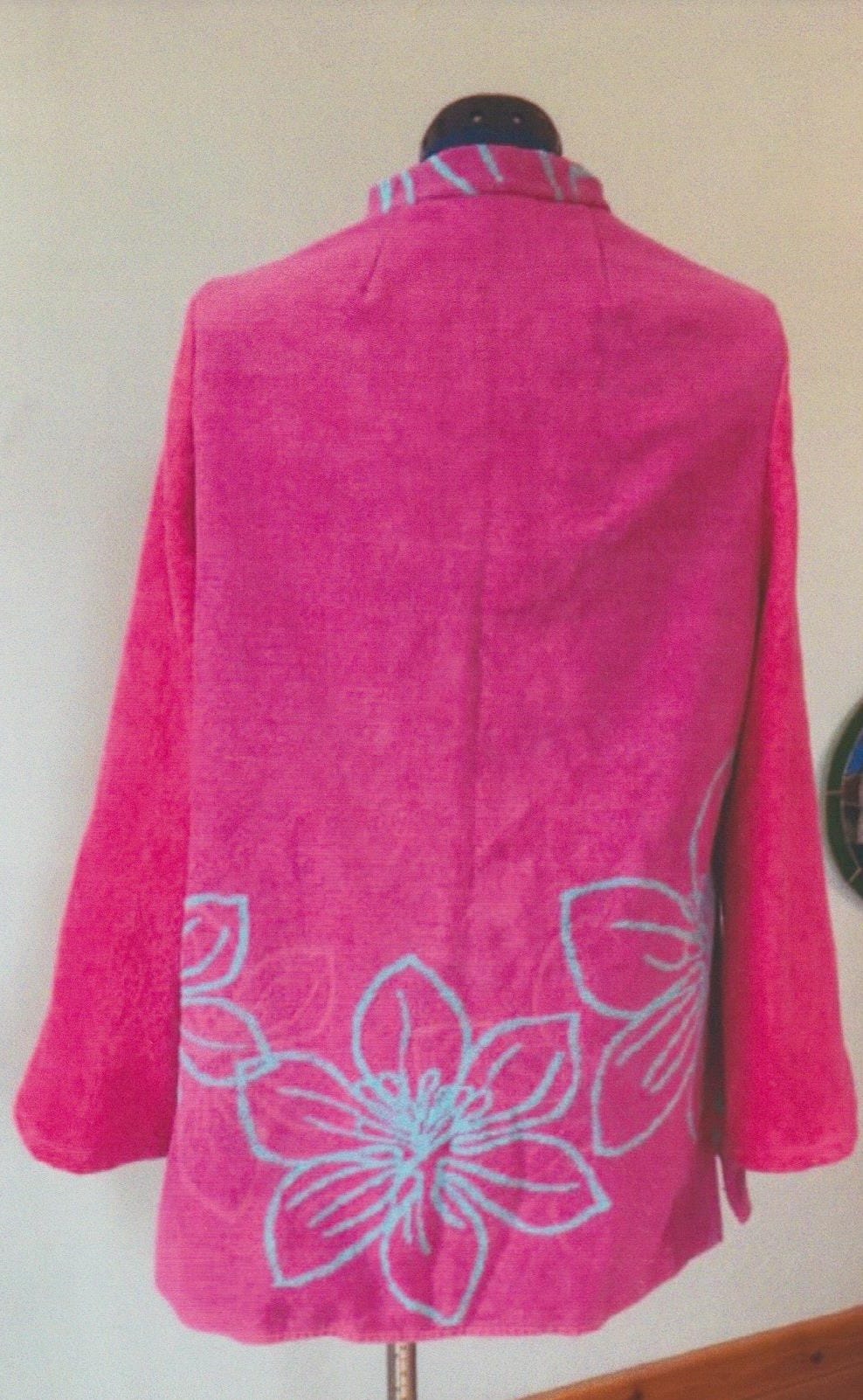
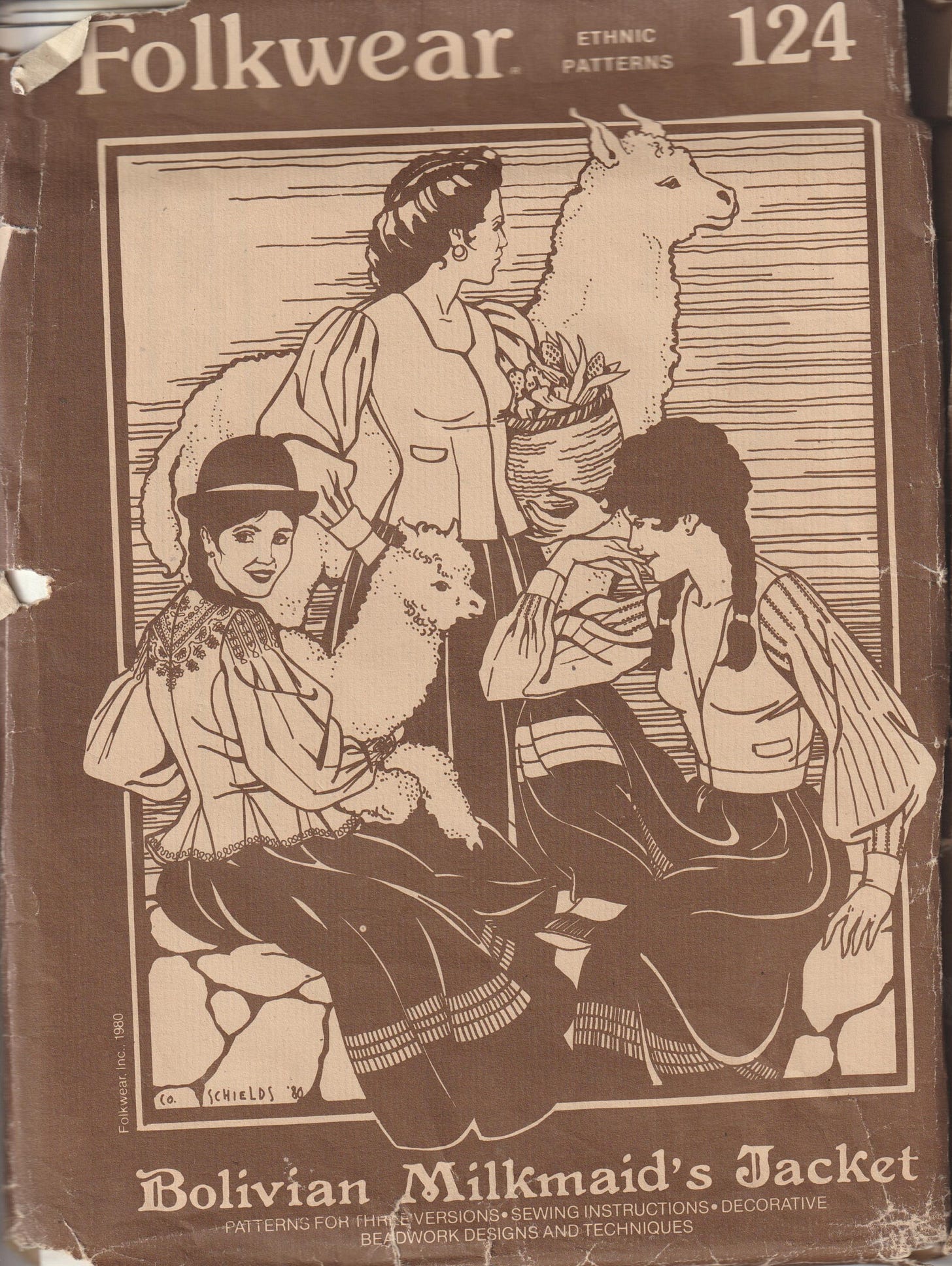
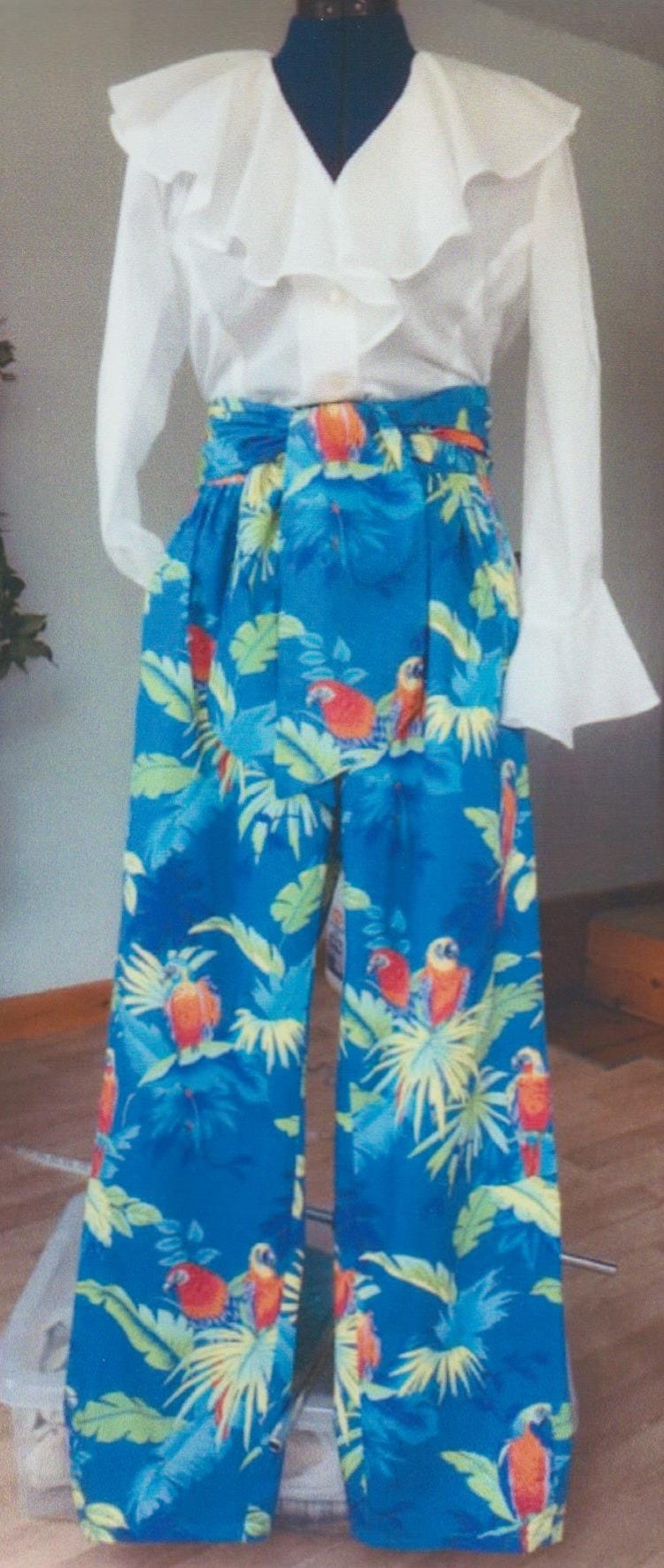

Aw, that was a wonderful read through the history of your sewing, Annie! Thanks so much for sharing pictures of some of your garment (wow, that wedding outfit is spectacular!), and your machines. I don't sew myself, but I know enough to know what to look for when I shop secondhand, and can always spot a well-made hand-sewn garment. They're treasures! Thank you!
What a wonderful memoir! I used to make all my clothes, long, long ago. So fun for me to read your tale. Thank you for sharing, Anne.